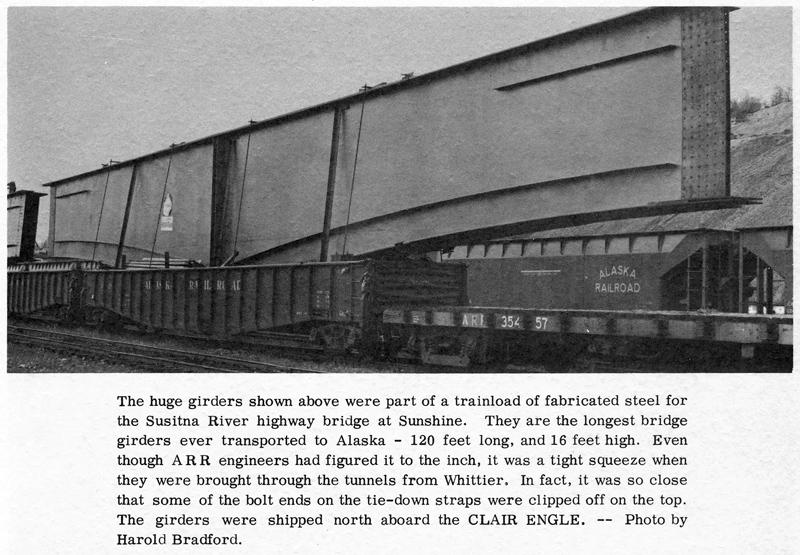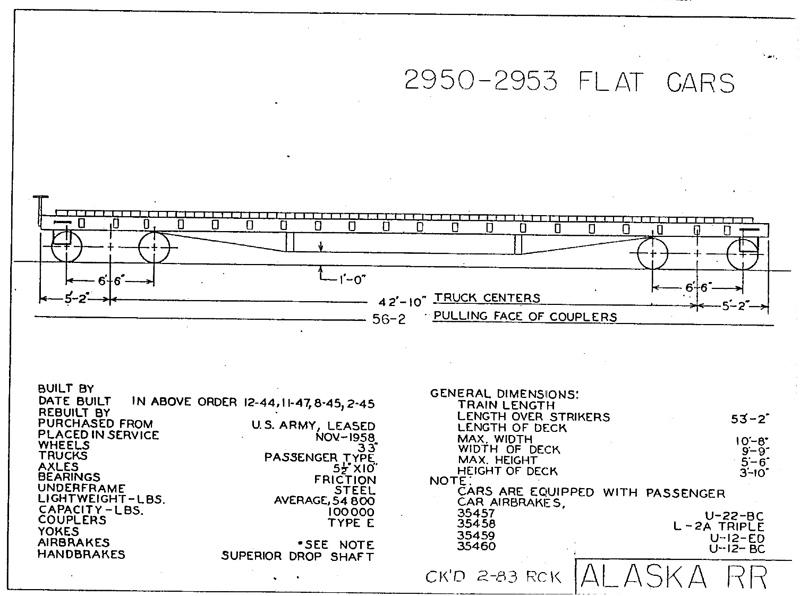
.
At
the top of Page 925 in The Alaska Railroad by Bernadine Prince is an impressive
photo of steel bridge members loaded on 65 foot mill gons. This
movement was made from Whittier to the Parks Highway Susitna River Bridge site
near the Sunshine Section. The idler car #35457 in the foreground
caught my eye due to the unusual truck under the car.

Searching Equipment Register No. 12-6 of 1963 revealed no such number. Nothing like a mystery! Eventually an Alaska Railroad clearance drawing of the 2950-2953 Flat Cars landed on my desk and in reading the details the fog began to clear.

First the mention of Passenger Trucks, the Note that reflects four car numbers starting with 35457 and the PLACED IN SERVICE Nov-1958 proved they were on the property. So why were these cars not on the 1963 roster when 35457 was clearly labled ARR and in regular service. Note the Purchased From indicates they were "U.S. ARMY, LEASED". Since they were leased they were not on the ARR Roster.
By the time the 1973 Roster was printed the 2950-2953 flats magically appear with note they were equipped with Corner Posts for Container and General Service. Evidently the railroad purchased the four lease cars and at that time, renumbered them in order.
In the June 1984 Roster the class had grown to 6 cars #2950-2956. The Roster of February 1996 lists only three remaining cars in non-revenue or MOW service #2954-55-56 with a note TYPE F1A. By that time all these cars would have exceeded their FRA 50 year retirement date. None of these cars appear on the 2003 roster.
Note: All measurements for the model materials are given in prototype feet and inches so you can build the car in any scale.
The model of #2950/35457 evolved from the photo of half the car and the clearance drawing. Passenger style trucks with a 6' 6" wheel base and the U. S. Army heritage lead to the conclusion these were hand me downs from the U.S. Army's Hospital Kitchen Cars. Some Hospital Kitchen Cars found their way onto other roads as express cars and 39 units were obtained by AMTRAC to become short (50ft) baggage cars.
Train Station products Kit #458 is an accurate model of these short 6' 6" trucks with clasp brakes. Assemble the trucks, leaving off the shock absorber and external brake cylinder. After the wheels are installed, make 4 brake beams from 4" scale styrene angle as a tight fit between the back of the brake shoes. Glue a piece of 1" scale wire cut 6 scale inches longer than the brake beam and ACC the wire to the inside of the angle so a scale 3 inches extends out each end of the brake beam. From the back side, enlarge the center cast hole in the back of the brake shoes to accept the wire and then snap the brake beams in place.

The clearance card indicates #35457 was equipped with the U-22-BC brake system which is close to the Cal Scale kit AB-800 offered by Bowser. When you have the under frame completed assemble the brake system components and install them, noting the B end orientation where the brake wheel staff will go. These large component add distracting detail to an otherwise simple under frame.
Attention to the clearance drawing dimensions resulted in a simple scratch building construction project.
The car was formed over a foundation of styrene measuring 9'4" by 52'8" cut from a sheet 5 scale inches thick.
The perimeter of the car is then formed by styrene strips 3" by 13" cut to length and glued flush with the top deck.
Bolster centers were located and a bolster of the 3"X13" styrene was added between the side sills.
The center beam was fabricated in place from two parallel strips of 20" by 10" styrene angle cut to the contour indicated by the clearance drawing. To add weight to the car, I sandwiched 1/8" sheet lead between the two vertical strips which were then glued to the foundation piece between the bolsters. The final cap was a strip of 22" by 3" styrene glued to the bottom of the sandwich to close it up.

Coupler buffers made from a 3"X4" styrene strip were added on each end of the car over the coupler pocket.
The wood deck, is wood, as I found a long abandoned package of Kappler Scribed 8" siding #KP007 P12 which was 1/32 inch thick. That turns out to be the 3" by 8" nominal car decking needed for the car. This was cut to the finished deck width of 9' 10" and held about 4" short of the end sill on both ends.
Prior to installation I used a zona saw to carefully extend the scribe mark through the end section cut so each board looks to be independent.

While the trucks are unique so are the 20 stake pockets on each side of the car. No commercial part could be found that was right so I fabricated all 40 of them. Really, it was not that difficult. With styrene strip that measured 5"by 5" in cross section, I cut 40 pieces 12" long on my "Chopper". I marked center lines down the bottom edge of each side sill to indicate the correct position for each pocket. The first three on each end are slightly closer together than those between. After these were attached with several applications of MEK over an 8 hour period, I then "drilled" the spike hole in each pocket with a sharp strait pin mounted in a pin vise. I just worried an indentation in the styrene and then lightly top sanded off the distortion this caused in the surface. The impression of a nice hole remains. So how do these solid stake pockets become pockets? After applying the mineral red paint job, go back with a small brush and put a dot of flat black paint on the top and bottom of each pocket. Let the paint do the work. When the finished car is viewed your eye tells your mind those are great stake pockets. Believe your eyes, because I could not think of another way to do it.

Kadee #158 scale couplers are assembled and the box glued directly to the bottom of the foundation. Adding a single Kadee red fiber washer between the truck and the car bolster will put the couplers and the car deck at perfect height.
Mineral Red paint came from a Krylon oxide red primer spray can. Let it dry in a warm place for 24 hours and then apply decals direct, NO GLOSS COAT. Poly S Mineral Red is an exact match for touch up. Decals are a mix of left overs from sets purchased from Roundhouse Hobbies.
This scratch built car is a great addition to the roster and you can get two for the price of one. One side is #2950 and the other side is #35457, after all they are in fact the same car.

Parts List:
If you have never scratch built a car body before here is an excellent first project. Total investment was about $20.00 for me as I had most of the materials except the trucks and couplers.
Added 2/14/09:
John T. Gray, a fellow modeler, who grew up on the Alaska Railroad
and later worked for them before moving on to the UP , was good enough
to correct a common error in our account of the 3500 series cars. In
black and white photography, black, red, green can all appear the same. So
can the lettering in yellow and white.
"I noticed your item about the 2950 series flatcars on the alaskarails web
site. I hate to be the one to tell you - but - these cars were painted
army/coach green when I knew them (as 35000's). Some may have been repainted
when renumbered for ARR but I never saw one that was red. I remember them very
distinctly back in the 60's and the last one I saw was in the early 80's. As
I understood it, they were acquired from the Army, as you note. However, they
were originally designed and built new to move Army equipment in conjunction
with troop movements in the states and thus, had to have passenger trucks to
operate at passenger train speeds in the states. Running these mixed trains was
something the Army did pretty frequently back then and we did it up into the
80's in Alaska. I also remember seeing some of them at Ft Eustis, Virginia when
I was stationed there briefly in 1972. Since I remembered them from ARR,
I asked about them and was told that they were a pretty standard item for the
Army's rail equipment. Obviously, they were too light duty to handle very
heavy equipment such as tanks. However, they were the utility flat of choice
for jeeps, trucks and other light vehicles. You can still occasionally find some
of them tucked around on the backs of bases in the states." John
T. Gray
So, thanks to John, I now can justify building a second 35000 series car and
giving it a light pullman green, that is weathered O.D. paint job with white
lettering as was common on military equipment. I am going to believe that
the ARR actually painted the 2950 series mineral red when they moved them to
the official roster and renumbered them. Can't wait to see who can burst
that bubble with a color photo of the cars.